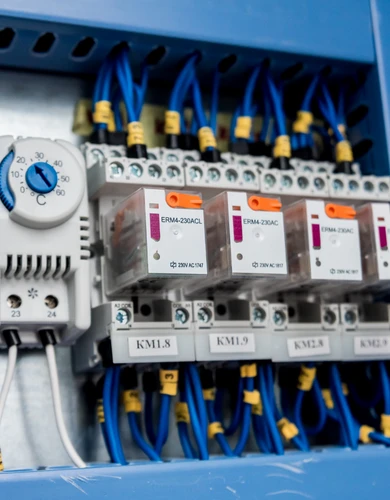What Market-wide Half-Hourly Settlement means for businesses
By the end of 2025, nearly every property in Britain will have a smart meter that automatically tracks and sends electricity usage data in real time.
This digital revolution has enabled a major change in the energy market: the Market-wide Half-Hourly Settlement (MHHS) reform.
MHHS will overhaul how suppliers buy and sell electricity, using actual energy usage data every 30 minutes. This means more accurate billing, smarter tariffs, and greater support for the push towards net zero.
For businesses, this reform could bring both opportunities and challenges. In this guide, we explain the impact of MHHS on business customers. Here’s what we cover:
- What is Market-Wide Half-Hourly Settlement (MHHS)?
- How does MHHS work?
- How will MHHS affect businesses?
- What businesses need to do to prepare for MHHS
- Market-wide Half-Hourly Settlement timeline
What is Market-wide Half-Hourly Settlement (MHHS)
Market-wide Half-Hourly Settlement (MHHS) is a major reform in the British electricity market that changes how energy suppliers pay for the electricity their customers consume.
Under the MHHS reform, all electricity consumers, including homes and small businesses, will transmit half-hourly (HH) energy consumption data to improve demand forecasting accuracy for suppliers and generators.
The change is being driven by the energy regulator Ofgem, and the rollout is expected to be completed industry-wide by 2027.
Before we dive into the technicalities of what’s changing, we’ll cover the key reasons behind the MHHS reforms.
Improving the accuracy of market settlement
The electricity market settlement process ensures that suppliers pay for the actual electricity their customers consume while generators and network operators receive payments accordingly.
However, the current system relies heavily on estimated consumption for most homes and small businesses, as live data isn’t available. This often leads to discrepancies where the amount of electricity consumed differs from the estimates. These imbalances cause additional costs that are currently shared across all electricity consumers.
The market reform will reduce imbalance costs and make the market more accurate.
Time-of-use tariff innovations
The MHHS reform is expected to encourage suppliers to offer innovative new tariffs that enable small businesses to participate in providing demand flexibility.
Here are some examples of expected tariff innovations:
- Dynamic time-of-use tariffs – A tariff where the business electricity price per kWh changes dynamically depending on actual market conditions. This would allow highly flexible business operations to adapt their consumption to market pricing.
- Critical peak period tariffs – A tariff that offers businesses a rebate for significantly reducing consumption during periods of extreme demand on the grid.
- Vehicle-to-grid tariffs – A tariff for businesses with an EV fleet that allows charging to be dynamically timed to align with periods of low demand on the grid.
- Battery exports – A Smart Export Guarantee tariff that enables the grid to utilise stored energy from solar batteries during periods of high demand.
These tariffs will financially incentivise consumers to be more adaptive in the way they use electricity.
Reducing the cost of electricity
Ofgem forecasts that changes in consumer behaviour resulting from the MHHS scheme will lead to long-term reductions in the overall cost of electricity.
The MHHS scheme will incentivise households and businesses to actively shift their demand to reflect the availability of power on the grid. This is expected to have two key impacts that will help reduce electricity costs for all consumers:
- Reduced balancing system costs – Demand-side flexibility will reduce the need for the grid to activate older, expensive fossil fuel power plants to meet demand. This will help reduce BSUoS charges for both businesses and households.
- Minimising infrastructure development – Demand-side flexibility will help lower peak demand on the grid, reducing the need for network upgrade work carried out by distribution network operators. This will help reduce DUoS charges for both businesses and households.
Supporting decarbonisation
The expected change in consumer behaviour will also support efforts to decarbonise the national grid by:
- Encouraging investment in local battery storage – Adding more carbon-neutral backup power capacity.
- Reducing reliance on backup emergency power – Decreasing the need for gas power stations to fill shortfalls in demand.
- Enabling the integration of more renewables – Supporting increased use of UK wind farms despite their variable power generation.
Each of these will help reduce the carbon intensity of power supplied on the national grid.
How does MHHS work?
To explain how Market-wide Half-Hourly Settlement works, we will look at each element of the energy industry that will change due to the reform.
Metering of electricity usage
Currently, there are three separate metering processes in the energy market:
- Half-hourly meters – Properties with a high demand for energy already have meters that transmit readings every 30 minutes.
- Smart meters – Meters that automatically send readings but are usually configured to do so only once per day.
- Traditional meters – Meters that require manual meter readings, usually taken by suppliers once a year.
With the finalisation of the smart meter rollout and the introduction of MHHS, most older meter types will be upgraded to smart meters. All smart meters will be configured to transmit meter readings every thirty minutes.
Data collection
Currently, the data collection process for half-hourly meters requires third-party data collectors and aggregators.
The MHHS reform will centralise all meter types’ metering and data services.
Market settlement
The electricity market settlement process that matches electricity purchases against consumption already occurs on a half-hourly basis.
However, the demand profile from smaller commercial properties and homes is currently estimated in this process.
Under MHHS, the settlement process will be based on actual data from all types of smart meters.
Settlement timeline
Currently, the market settlement process allows a 14-month period to enable adjustments based on physical meter readings from traditional meters.
The MHHS reform introduces a significantly shorter timeline for adjustments. This will require energy suppliers to arrange physical meter readings for older meters more frequently.
How will MHHS affect businesses?
Below, our experts highlight the key impacts of MHHS on businesses.
Pricing based on time-of-use
The MHHS scheme will enable businesses of all sizes to take advantage of time-based business energy tariffs.
It’s important to note that this is not mandatory; businesses can still choose a simple, single fixed-rate business energy tariff if preferred.
Above, we’ve listed a range of innovative new energy tariffs that are expected to become available due to the Market-wide Half-Hourly Settlement reform.
Smarter data insights
MHHS will mean that all businesses generate granular and timely energy usage data through automatic meter readings.
This presents an opportunity for businesses to access business energy consumption data analytics through:
- An online portal provided by your business energy supplier.
- Third-party business energy monitoring software.
These analytics will provide insights for businesses, enabling them to improve business energy efficiency.
Demand flexibility opportunities
The MHHS scheme will allow businesses of all sizes to participate in demand-side flexibility schemes.
These schemes offer incentives for businesses to reduce their energy usage during periods of high demand on the grid.
Currently, the most popular flexibility scheme is the Demand Flexibility Service. Find out more in our guide to the demand flexibility service for businesses.
Meter operator costs
Most businesses pay meter operator costs through their tariff’s business electricity standing charge.
MHHS is changing the roles and responsibilities for meter communication and data aggregation.
It is currently unclear whether these changes will increase or decrease metering costs for most businesses.
What businesses need to do to prepare for MHHS
There are currently no mandatory actions for businesses to prepare for MHHS.
However, our energy experts have two recommendations for actions businesses can take to get ahead of the upcoming changes.
Check if you have a smart meter
MHHS relies on a smart business electricity meter installed at all commercial properties to transmit automatic meter readings every thirty minutes.
This requires having one of the following meter types:
- Half-hourly business energy meter
- AMR business electricity meter
- Smart business energy meter
Older traditional “dumb” meters, including Economy 7/10 meters, must be upgraded ahead of the scheme.
Your business energy supplier is responsible for upgrading your meter and will be required to do so before the end of 2025. Most suppliers will accept requests for early upgrades.
We recommend checking a recent business electricity bill to confirm that automatic meter readings are being used. Contact your supplier’s customer service team if there appears to be a problem.
Review your energy contract and tariff
The MHHS programme will not affect the status of your existing business energy tariff. It will also remain possible to continue with simple, single-rate fixed tariffs in the future.
However, the rollout of smart meters and the transition to half-hourly settlement provide businesses with the opportunity to take advantage of multi-rate business energy tariffs.
Explore the options currently available in the market using our business electricity comparison service.
Market-wide Half-Hourly Settlement timeline
Here is the current timeline for the Market-wide Half-Hourly Settlement scheme:
- September 2025 – MHHS migration of MPANs begins, with suppliers moving customers to new settlement agreements.
- December 2025 – End of the smart meter rollout.
- May 2027 – Deadline for MPAN migration.
- July 2027 – Ofgem’s target for completion of the MHHS programme.
💡 MHHS is still in the testing phase, so these rollout dates may change as the project progresses.
Market-wide Half-Hourly Settlement (MHHS) Scheme FAQs
Our business energy experts answer key questions that business owners are asking about the MHHS scheme.
How do I arrange MHHS set up?
Individual businesses are currently not required to take steps for the MHHS scheme. All actions required for MHHS are the responsibility of energy suppliers and other participants within the energy market.
What is the Target Operating Model (TOM)?
The Target Operating Model (TOM) is the blueprint for how the settlement process will work in the wholesale electricity market once MHHS is implemented.
TOM replaces the old system with a streamlined, centralised model that enables all customers to be settled based on their half-hourly usage.
Can you switch energy suppliers during the MHHS transition?
Yes, the MHHS implementation has been designed to allow households and businesses to continue switching energy suppliers.
Find out more about the process in our guide to switching business energy suppliers.

